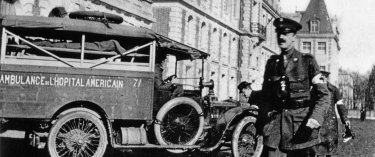
The American Hospital of Paris during the Great War
Watch our documentary
The hub of American aid in France
When it was founded in 1906, the American Hospital of Paris was a small 24-bed hospital. By August 1914, when Germany declared war on France, it had been transformed into a military hospital with more than 600 beds. When the war was at its worst, the hospital, combined with the surrounding field hospitals and other affiliated care centers, had as many as 2,000 beds.
On August 3, 1914, the American Hospital of Paris Board of Governors, led by U.S. Ambassador to France Myron T. Herrick, offered its facilities to the French authorities.
In exchange, France gave the hospital access to the large buildings of the nearby Lycée Pasteur and offered to finance a large, avant-garde military hospital there: the Ambulance of the American Hospital, Wounded Division.
Unprecedented generosity
Until April 6, 1917 and the United States’ entry into the war a few months later, the American Hospital of Paris was the epicenter of thousands of people’s volunteer efforts as well as a massive influx of American donations. 75 associations, federated as the Allied War Relief, estimated that close to $1 billion (in today’s dollars) had been raised between 1914 and 1917 to finance the conversion of Lycée Pasteur, the ambulance fleet, field hospitals and humanitarian aid.
But the United States provided more than just monetary aid; in the space of three years, teams of doctors, nurses and ambulance drivers would go to the American Hospital to transport, treat and perform surgery on hundreds of thousands of wounded persons.
Most did so to pay France back for the crucial support it provided during the American Revolution, as illustrated by the famous words of General Pershing on arriving in France in 1917: “Lafayette, we are here!”
Our souls were tormented by stories and visions of horror that were impossible to forget – hundreds of men abandoned for days, with no food or water […] who couldn’t be moved because the railways were being used by trains to transport troops and munitions.
The Motor-Ambulance Corps of The American Hospital
In September 1914, after the Battle of the Marne had begun, an officer called the U.S. Ambassador to France, Timothy Herrick, to inform him that some 1,000 injured soldiers with no means of transportation, located 50 kilometers east of Meaux, were in desperate need of help. Ambassador Herrick called everyone he knew who owned a car. They all rushed to provide assistance, carrying 34 injured soldiers on their first run and making additional trips to transport those who remained. This impromptu convoy, born of the situation’s urgency, was the beginning of the American Hospital’s motor-ambulance corps.
The American Ambulance Field Service, which later became the American Field Service, still operates today. Over the course of the war, this fleet of volunteer drivers risked their lives to carry some 400,000 wounded soldiers to the hospital.
Spectacular medical advances
In January 1915, American medical schools began a series of rotations at the Ambulance of the American Hospital, where pioneering doctors were taking care of up to 1,600 wounded persons per day by the end of 1916.
Their medical knowledge and skills were vastly improved by working on wounded soldiers, leading to significant medical progress under these trying circumstances.
-
Nitrous oxide anesthetic
Dr. George Crile, a surgeon at Lakeside Hospital in Cleveland, together with his chief anesthetist Agatha Hodgins, developed a formula based on nitrous oxide that put patients to sleep without inducing a state of shock. Physicians came from all over Europe to witness the anesthetic being used in surgery on wounded soldiers.
-
Neurosurgery
Professor Harvey Cushing, often described as the father of neurosurgery, ran the surgical unit of the American Hospital of Paris. There he experimented with the use of electromagnets to remove shrapnel from the brain. He also developed techniques to repair nerve lesions caused by war weapons.
-
The dawn of plastic surgery
Reconstructive facial surgery was developed, allowing disfigured war veterans at the American Hospital of Paris to benefit from innovative techniques to reconstruct their damaged faces. One technique consisted in moving flaps of healthy tissue to the wound site to reform the facial features.
-
Antiseptic
Henry Dakin and Alexis Carrel developed their method of soaking wounds with a powerful antiseptic to prevent infection without attacking the flesh.
In this place there is a most amazing aggregation of talent […] men and women serving with whole-souled devotion – it all is a most creditable thing for American enthusiasm and prompt action to have put through.
Recognized as an institution of public benefit
March 19, 1918: To thank the Hospital for services rendered to France, the French government decreed:
“The charitable organization known as The American Hospital of Paris is recognized as an institution of public benefit.”
A second decree signed by Raymond Poincaré authorized the hospital to receive donations and bequests under French law
Chronological landmarks
-
August 3, 1914
Germany declares war on France; German troops invade Belgium
-
September 6-13, 1914
Battle of the Marne; the German advance was stopped a few kilometers from Paris
-
April 6, 1917
Congress voted for the country to formally enter the conflict alongside the Allied Powers
-
June 28, 1919
Signature of the Treaty of Versailles
